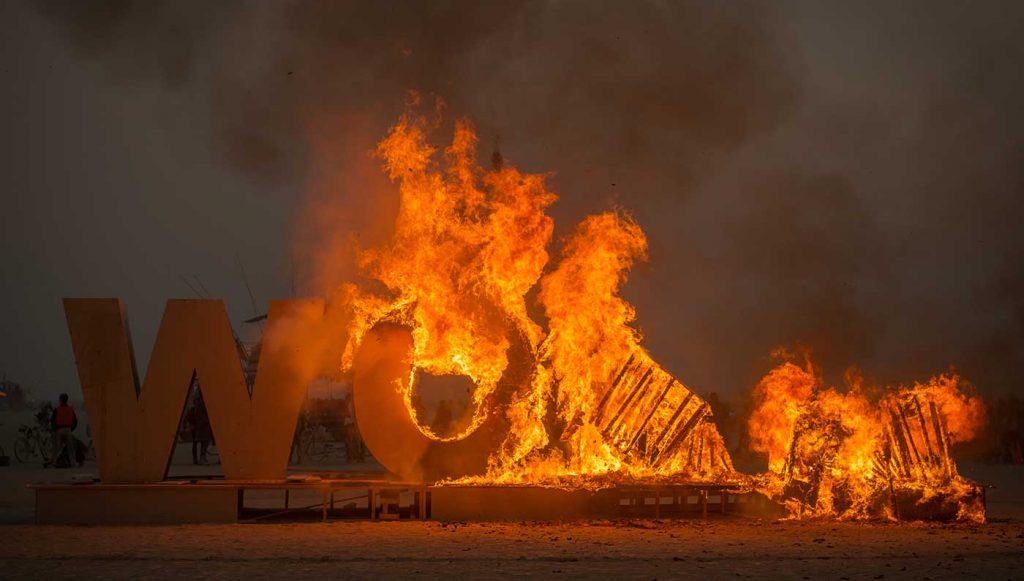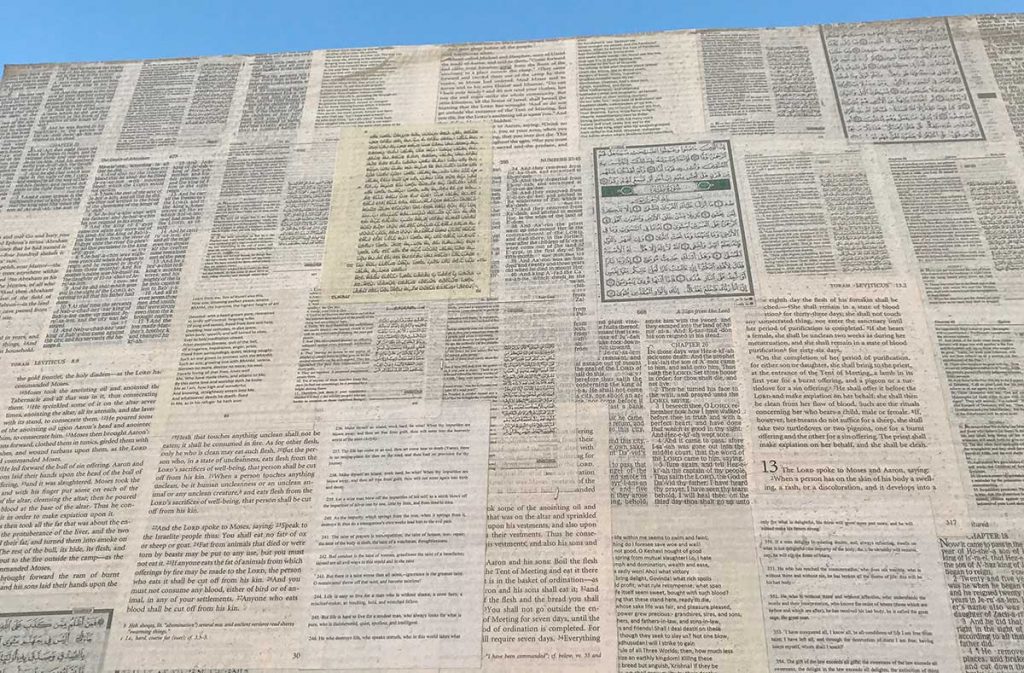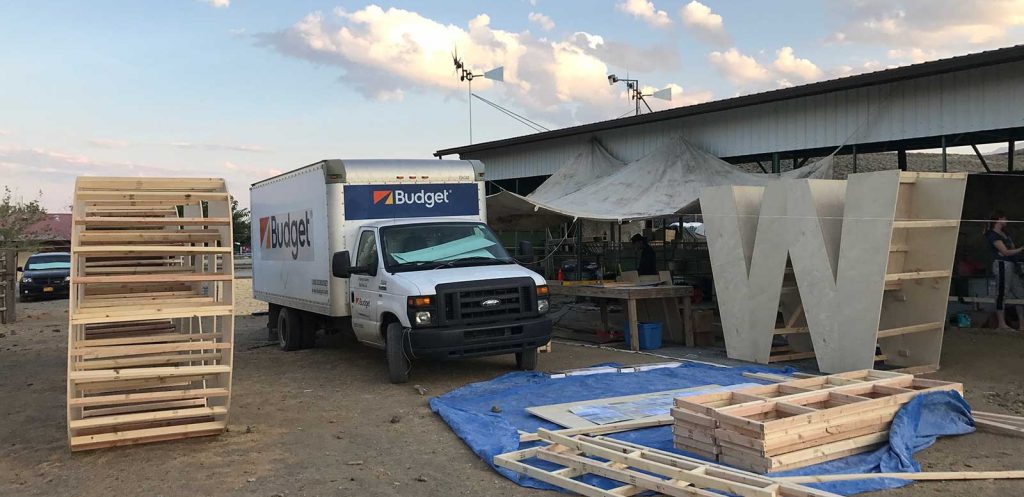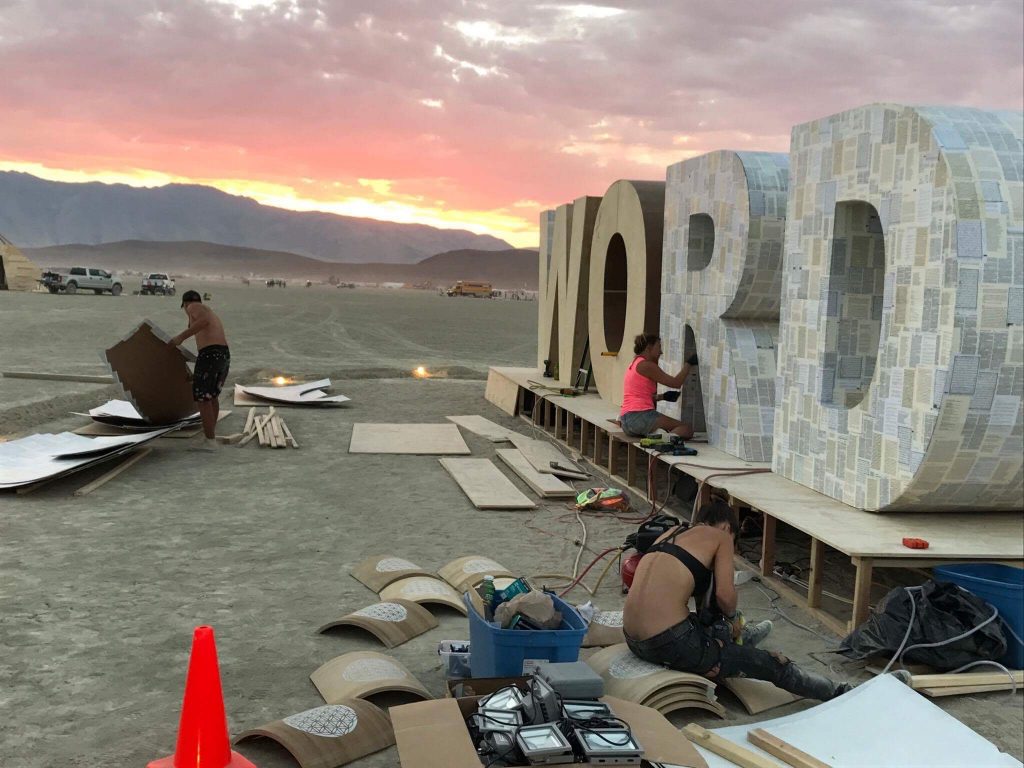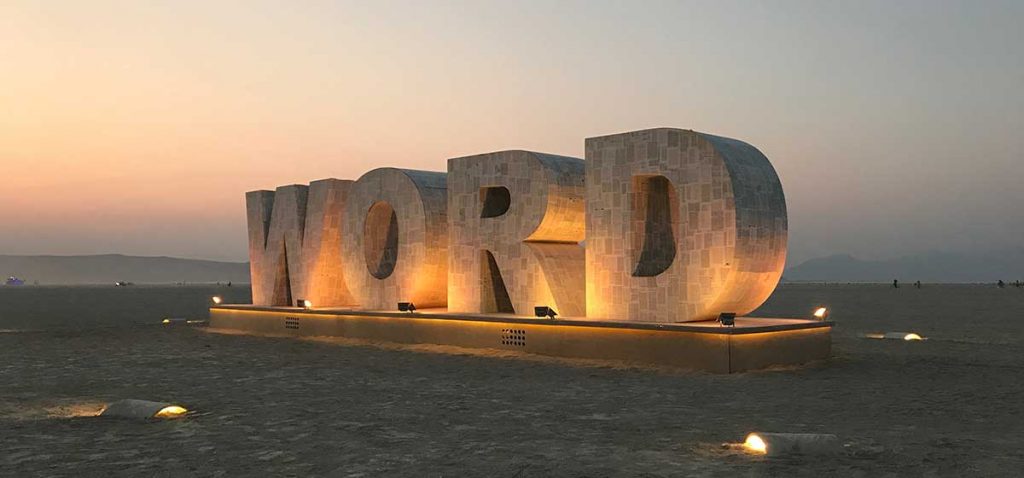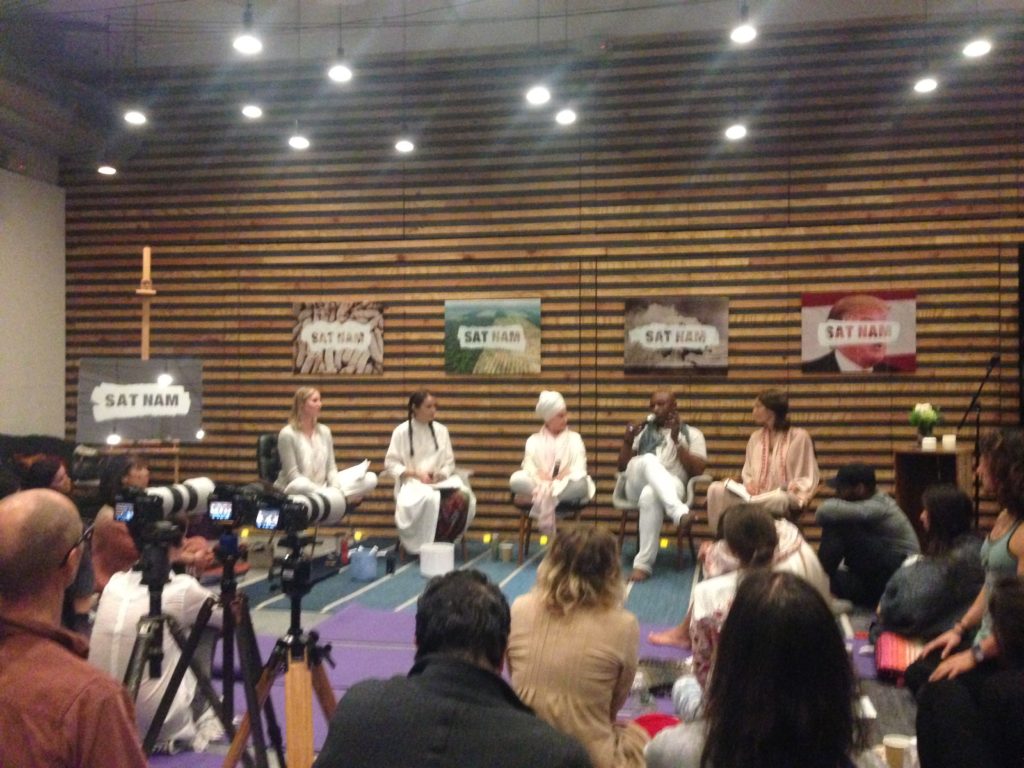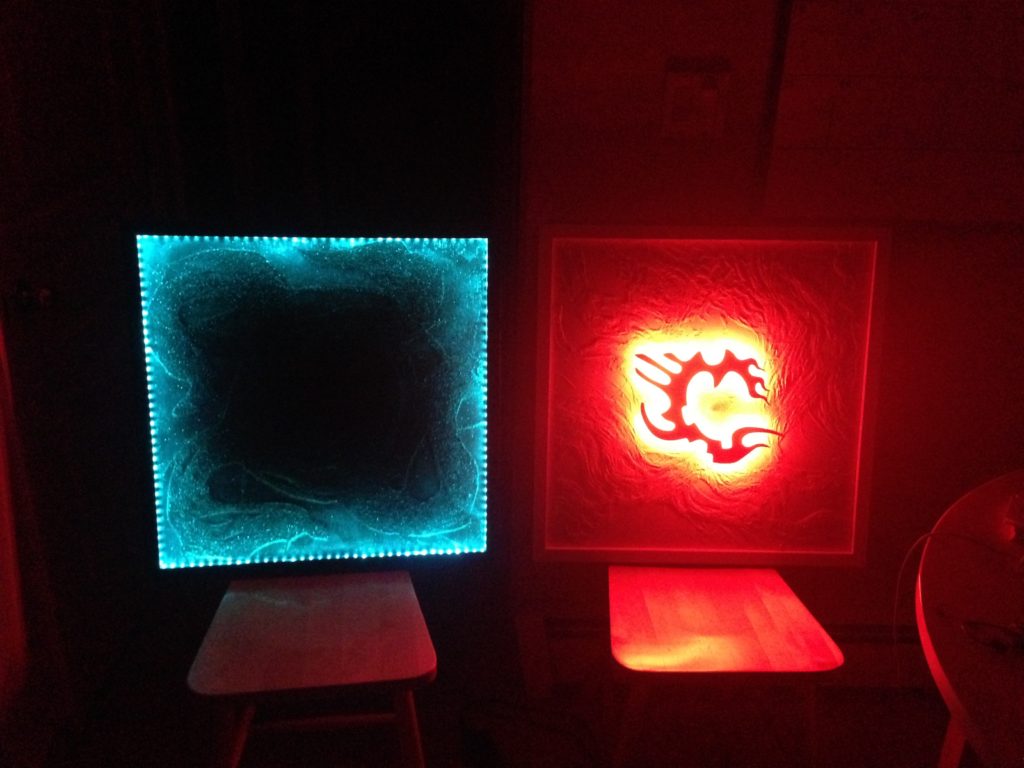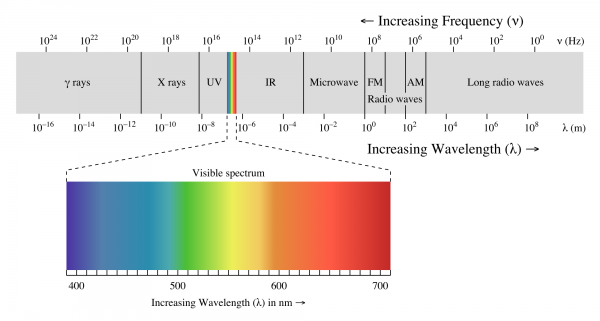Burning Man 2017 marked my eleventh burn in a row and the first year that I brought a piece of art to the playa.
WORDLESS was a large three-dimensional word made out of wood. It stood 10 feet high and 40 feet wide. The word that was displayed was “WORD” and the surface of the structure was covered in pages of scripture from many of the world’s major religions: the Torah, the Bible, the Koran, the Bhagavad Gita, the Dhammapada, and the Tao Te Ching. The structure had a hidden sound source embedded inside it which emanated a deep rumbling “OM” vibration. A circular perimeter around the structure was lined with meditation benches, inviting people to sit and just be for a moment. The structure itself was burned on Friday morning as the sun was rising.
The original idea for WORDLESS was seeded a couple years ago, loosely inspired by the word sculptures that I had seen on the playa. I think the idea started as something like, “what if you had a word and it said WORD!” As the concept evolved, I associated the biblical reference to John 1:1 (“In the beginning was the Word, and the Word was with God, and the Word was God.”) and thought of covering the word in pages of scripture from many different religions. When I first thought of the idea it seemed far too controversial and I didn’t feel like I was in a place to work with scripture in that way.
Burning Man 2016 brought the project back into my mind and gave me a deeper sense of clarity about the intention behind the work. I came out of that burn feeling a sense of wholeness and surrender. I had what you might call a mystical experience – a brief glimpse into something that felt very much like God. It’s hard to explain the experience but it was so simple – God just is and is everything and we are an expression of that. The experience profoundly affected me and formed the basis of my intention for the WORDLESS project.
The project seemed even more timely given the theme for this year’s burn, Radical Ritual. Burning Man described it briefly as follows:
Beyond the dogmas, creeds, and metaphysical ideas of religion, there is immediate experience. It is from this primal world that living faith arises. In 2017, we will invite participants to create interactive rites, ritual processions, elaborate images, shrines, icons, temples, and visions. Our theme will occupy the ambiguous ground that lies between reverence and ridicule, faith and belief, the absurd and the stunningly sublime. The human urge to make events, objects, actions, and personalities sacred is protean. It can fix on and inhabit anyone or anything. This year our art theme will release this spirit in the Black Rock Desert.
Part of what I wanted to convey was this idea that we add so many layers of abstraction and interpretation on top of something that is so simple. People create complexity – all these rites, rituals, and tasks that must be accomplished in order to connect with God – when the truth is we are a perfect expression of God as we are and we are closest to that aspect in the depth of our own being.
This is why the project was called WORDLESS. First, because this aspect of God is impossible to truly capture in words and, second, to symbolically burn away all these words and layers of abstraction to just be with ourselves as we are.
One of the challenges in initially trying to share the idea for this work with other people was properly conveying the intention behind the project in a way that people could understand what I was trying to say by combining scripture with such a seemingly simple word. Personally, I found myself constantly peeling back many layers of meaning and this was part of the richness and challenge of the piece for me. There was also a certain irony in trying to use words to describe a project called WORDLESS. The following was part of the original write up:
Scripture speaks of word, vibration as the source of all creation. Humans are endowed with this power of spoken word. We use words to create the world we live in. Our understanding of ourselves as an expression of creation, created in the creator’s image, and creators in our own right is the foundation of conscious creation.
Thus we are confronted with the power of our own words. And we burn the word to reestablish our connection to the word, to the purity of our own use of the word, and the purity of our own understanding of ourselves as expression of God’s vibration. We let go of all the concepts that we have created on top of the word to just be as we are.
I had an opportunity to engage with many different people from different faiths about their reaction to this work. The most sensitive aspect of the project was my intention to burn the scripture. Jewish people, in particular, had a very hard time with the idea.
It was Hari Kaur, my Kundalini yoga teacher, who emphasized my own lack of grounding in the subject. Although devotion to God is at the heart of my daily aspiration, I do not have any formal background with religious tradition or scriptural study. As one Rabbi I spoke with put it, it’s very easy to make a strong statement using a medium that means little to you and everything to someone else. I found this aspect of my relationship to the subject matter troubling. In my heart, I felt that it was ok for me to work with scripture as a medium but I also felt that I had to bring more mindfulness to my understanding of what I was working with.
I enrolled into a series of religious literacy courses out of Harvard on EdX. The first course I took was on Judaism and it made me appreciate just how central the Torah is to the Jewish identity. My continuing conversations led to the insight that burning scripture was profoundly disrespectful to some of the traditions represented in the texts I was using. It was hard for me to assert a message about being and acceptance while simultaneously disregarding the beliefs of the traditions I was working with.
After some deep consideration, I decided to burn the word but not burn the scripture. The scripture itself was to be removed just before burning the word. In retrospect, this was an interesting compromise. At heart, my intention was to convey a message about going beyond words (scriptural or otherwise) to a deeper essence – to recognize the inherent simplicity of divine presence inside ourselves and everyday life. Part of the experience was the provocation of being confronted with the action of burning scripture as a catalyst to examine one’s spiritual values.
Not burning the scripture made the project much more fundable and it made it easier for people to get involved because the project was not intrinsically offensive to anyone. Over 30 people contributed to funding the project, and as many showed up throughout the week of Burning Man to support the build and burn process.
Would the burning action have made a significant difference in the experience of the piece? I am not sure. In the end, a level of compromise was reached through a process of extended dialog, weighing something that I felt strongly about against something that others felt very strongly about. Perhaps that, in itself, is a major source of insight and growth for all involved.
Interestingly, despite my desire to burn the scripture, treatment of the scripture was one of the most challenging aspects of the project for me. I felt a responsibility to be very respectful of each page I dealt with. First, at this scale and working in these conditions, it was very difficult to be delicate with every page I touched. But the real challenge was that I couldn’t extend my own sentiment to all the people that came by to help us and certainly not to all the people who experienced the piece after it was built. Simple things like treating the scripture with care, not putting the scripture on the ground, or not stepping on the scripture. There were many times I came by to see people climbing all over the piece. There was little I could do about this and it was very much an exercise in letting go.
In a way, the project was a metaphor for the many varieties of interpretation possible with scripture. Each person I spoke with had a slightly different interpretation of the piece. For one of my partners building the project, Krasimir, the project symbolized unifying all religions into one religion. For another good friend of mine, the project was about words and how we use them. For some, it was an opportunity to lose oneself in reading snippets of scripture that presented meaning in the moment or simply a place to sit and meditate. For others, especially those who only saw the structure from a distance, the piece was a tongue in check satirical reference to all the words seen on the playa. For me it was all those things, but mostly a desire to manifest an experience that would bring people into presence with themselves and God in some way.
As a side note, the experience of working on this project has opened up a whole new field of interest for me. I realized that the formal study of religion captures many of my many interests: governance, economy, education, philosophy, history, spirituality, community, dialog, art, and even technology. I am currently enrolled in my third online religious literacy course and this subject is increasingly becoming a focus of my study, art, and work.
Issues of religion are sensitive and this project was particularly provocative in that regard. The intention here was not to offend, but rather to encourage deep exploration and dialog around the meaning of spiritual values and identity. In that sense, it was very important for me to get as many people and perspectives involved to give the project more legitimacy.
One of the biggest highlights of this project was the incredible number of people that came together to make it happen. My wife, Natasha, spent countless hours supporting me in virtually every aspect of this project and Krasimir Alaykov, Natalia Rudakova, George Bakardjiev all joined as part of the dream team that spent endless hours in brutal conditions bringing the word to this world. Krasimir led the build effort and was instrumental in realizing every physical aspect behind the project. He is a master craftsman and his incredible attention to detail truly blew me away.
Much of the project was pre-built at Ivenson Ranch, just outside Black Rock City. JB runs a whole Burning Man art support service there and I was deeply touched by the support and kindness I experienced there. JB truly puts Burner spirit into practice with his operation.
I was also deeply touched by the support of Camp Merkabah. I still can’t believe how many people showed up to the burn at 5 am! From funding to build to burn, many people from the extended Merkabah community stepped up to offer tremendous help in making the project happen. Tommy Rom and David Shemesh in particular were instrumental in making the project a reality.
Actualizing this project was a tremendous experience for me. Literally every aspect of this project was community supported. I was deeply moved that almost 40 people came together to fund the project (we raised just over $13,000 between the camp, individual contributions, and a crowdfunding campaign) and many people contributed in other ways.
Working with the Burning Man organization itself was also a great experience. Annie Coleman from Art Support Services and Doxie from FAST (Fire Art Safety Team) were super professional and guided me every step of the way through my first art project. Both pre-playa and on playa, every request we made was handled in a timely manner and I felt really supported throughout the whole process.
On the playa, the project itself took a tremendous toll on me physically and was brutally difficult. Building the structure, doing gas runs every twelve hours to keep the generator running, preparing to burn it, burning it, then cleaning the ashes was a non-stop responsibility during the week of Burning Man. Natasha and I both ended up with severe colds and were completely knocked out by the end of the week. Creating art on the playa helped me appreciate just how much effort goes into every piece of work out there. It’s a serious commitment.
One of my favorite moments of the week was early during the build. It was around midnight and we had been working non-stop on the playa since 9 am. Our last meal had been around lunch time. A lone white van pulled up and a guy asked if we were hungry. I’m one of those super picky eaters (vegetarian, gluten and dairy free) so I was a little apprehensive. He mentioned something about Spanish style tapas, which sounded like it might have potential so I said sure… ten seconds later two pick up trucks pull up ranger style and two or three dozen people all dressed up in party gear jump out. Dance music starts playing, a large table is set up, and huge platters of gourmet food come out – cucumbers with gazpacho soup, roasted peppers, quiche, all sorts of fancy cuisine. This happens in the space of about sixty seconds. Mind blown. One of my all time most memorable moments on the playa. A very big heartfelt thank you to Feed the Artists for creating this magic. It truly touched my heart.
I have learned so much through this experience and received so much on a personal level. I am forever grateful to Burning Man and the incredible people that make it happen. So many people give so much to make Burning Man what it is and I am just deeply honored that I have had a chance to contribute back to this community somehow. Thank you, thank you, thank you.
The Tao Te Ching begins with the following words:
The Tao that can be spoken is not the eternal Tao
The name that can be named is not the eternal name
WORDLESS emphasized that God, or whatever notion of creation origin we might have, is inherently indescribable. Thus we acknowledge the word and simultaneously burn it to acknowledge the wordless source from which all words and things emerge. It is my sincere belief that as more people find this common source within themselves many of the challenges facing humanity will be addressed in a more constructive and harmonious way.
God bless.
Special thanks to Geoffrey Squier Silver for taking the top most photo of me sitting in front of the word.


